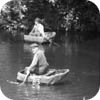
| Coracle
A coracle is a primitive type of boat. It is a light boat, oval in shape, and formed of canvas stretched on a framework of split and interwoven rods, and well-coated with tar and pitch to render it water-tight. According to early writers the framework was covered with horse or bullock hide (corium).
So light and portable are these boats that they can easily be carried on the fisherman's shoulders when proceeding to and from his work. Coracle-fishing is performed by two men, each seated in his coracle and with one hand holding the net while with the other he plies his paddle. When a fish is caught, each hauls up his end of the net until the two coracles are brought to touch and the fish is then secured.
The coracle forms a unique link between the modern life of Wales and its remote past. This primitive type of boat was in existence amongst the Britons at the time of the invasion of Julius Caesar, who has left a description of it, and even employed it in his Spanish campaign. They were historically common in the British Isles, but are now only rarely seen in areas of West Wales and Shropshire, notably on the River Severn. The Welsh Rivers Teifi and Tywi are the best places to find coracles in Wales, although the type of coracle differs depending on the river. On the Teifi they are most frequently seen between Cenarth, and Cilgerran and the village of Llechryd.
|
